Omid Taheri
InteractVLM: 3D Interaction Reasoning from 2D Foundational Models
Apr 07, 2025Abstract:We introduce InteractVLM, a novel method to estimate 3D contact points on human bodies and objects from single in-the-wild images, enabling accurate human-object joint reconstruction in 3D. This is challenging due to occlusions, depth ambiguities, and widely varying object shapes. Existing methods rely on 3D contact annotations collected via expensive motion-capture systems or tedious manual labeling, limiting scalability and generalization. To overcome this, InteractVLM harnesses the broad visual knowledge of large Vision-Language Models (VLMs), fine-tuned with limited 3D contact data. However, directly applying these models is non-trivial, as they reason only in 2D, while human-object contact is inherently 3D. Thus we introduce a novel Render-Localize-Lift module that: (1) embeds 3D body and object surfaces in 2D space via multi-view rendering, (2) trains a novel multi-view localization model (MV-Loc) to infer contacts in 2D, and (3) lifts these to 3D. Additionally, we propose a new task called Semantic Human Contact estimation, where human contact predictions are conditioned explicitly on object semantics, enabling richer interaction modeling. InteractVLM outperforms existing work on contact estimation and also facilitates 3D reconstruction from an in-the wild image. Code and models are available at https://interactvlm.is.tue.mpg.de.
NIL: No-data Imitation Learning by Leveraging Pre-trained Video Diffusion Models
Mar 13, 2025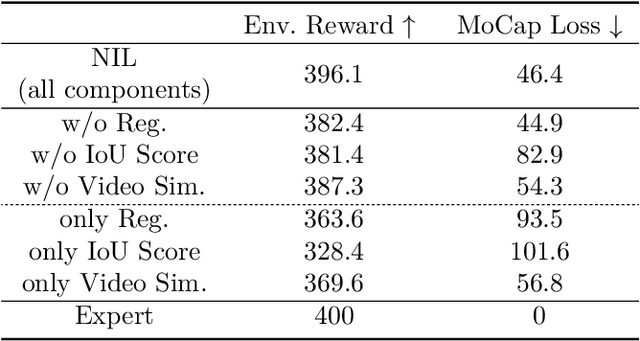
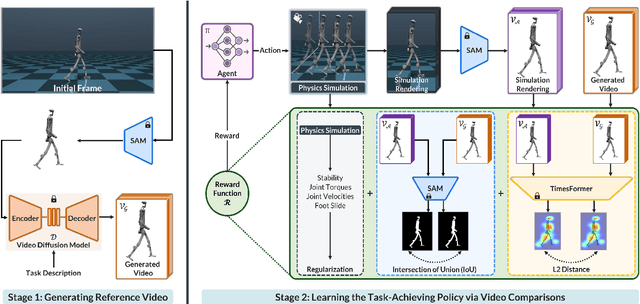
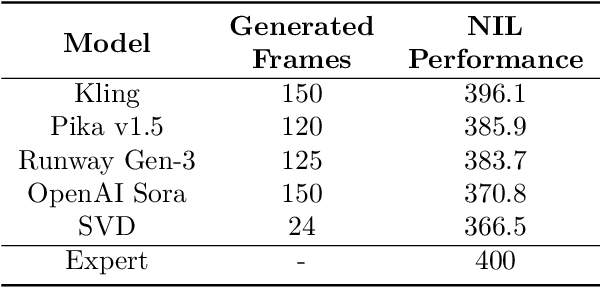

Abstract:Acquiring physically plausible motor skills across diverse and unconventional morphologies-including humanoid robots, quadrupeds, and animals-is essential for advancing character simulation and robotics. Traditional methods, such as reinforcement learning (RL) are task- and body-specific, require extensive reward function engineering, and do not generalize well. Imitation learning offers an alternative but relies heavily on high-quality expert demonstrations, which are difficult to obtain for non-human morphologies. Video diffusion models, on the other hand, are capable of generating realistic videos of various morphologies, from humans to ants. Leveraging this capability, we propose a data-independent approach for skill acquisition that learns 3D motor skills from 2D-generated videos, with generalization capability to unconventional and non-human forms. Specifically, we guide the imitation learning process by leveraging vision transformers for video-based comparisons by calculating pair-wise distance between video embeddings. Along with video-encoding distance, we also use a computed similarity between segmented video frames as a guidance reward. We validate our method on locomotion tasks involving unique body configurations. In humanoid robot locomotion tasks, we demonstrate that 'No-data Imitation Learning' (NIL) outperforms baselines trained on 3D motion-capture data. Our results highlight the potential of leveraging generative video models for physically plausible skill learning with diverse morphologies, effectively replacing data collection with data generation for imitation learning.
Humanity's Last Exam
Jan 24, 2025Abstract:Benchmarks are important tools for tracking the rapid advancements in large language model (LLM) capabilities. However, benchmarks are not keeping pace in difficulty: LLMs now achieve over 90\% accuracy on popular benchmarks like MMLU, limiting informed measurement of state-of-the-art LLM capabilities. In response, we introduce Humanity's Last Exam (HLE), a multi-modal benchmark at the frontier of human knowledge, designed to be the final closed-ended academic benchmark of its kind with broad subject coverage. HLE consists of 3,000 questions across dozens of subjects, including mathematics, humanities, and the natural sciences. HLE is developed globally by subject-matter experts and consists of multiple-choice and short-answer questions suitable for automated grading. Each question has a known solution that is unambiguous and easily verifiable, but cannot be quickly answered via internet retrieval. State-of-the-art LLMs demonstrate low accuracy and calibration on HLE, highlighting a significant gap between current LLM capabilities and the expert human frontier on closed-ended academic questions. To inform research and policymaking upon a clear understanding of model capabilities, we publicly release HLE at https://lastexam.ai.
Predicting 4D Hand Trajectory from Monocular Videos
Jan 14, 2025



Abstract:We present HaPTIC, an approach that infers coherent 4D hand trajectories from monocular videos. Current video-based hand pose reconstruction methods primarily focus on improving frame-wise 3D pose using adjacent frames rather than studying consistent 4D hand trajectories in space. Despite the additional temporal cues, they generally underperform compared to image-based methods due to the scarcity of annotated video data. To address these issues, we repurpose a state-of-the-art image-based transformer to take in multiple frames and directly predict a coherent trajectory. We introduce two types of lightweight attention layers: cross-view self-attention to fuse temporal information, and global cross-attention to bring in larger spatial context. Our method infers 4D hand trajectories similar to the ground truth while maintaining strong 2D reprojection alignment. We apply the method to both egocentric and allocentric videos. It significantly outperforms existing methods in global trajectory accuracy while being comparable to the state-of-the-art in single-image pose estimation. Project website: https://judyye.github.io/haptic-www
A Versatile and Differentiable Hand-Object Interaction Representation
Sep 25, 2024



Abstract:Synthesizing accurate hands-object interactions (HOI) is critical for applications in Computer Vision, Augmented Reality (AR), and Mixed Reality (MR). Despite recent advances, the accuracy of reconstructed or generated HOI leaves room for refinement. Some techniques have improved the accuracy of dense correspondences by shifting focus from generating explicit contacts to using rich HOI fields. Still, they lack full differentiability or continuity and are tailored to specific tasks. In contrast, we present a Coarse Hand-Object Interaction Representation (CHOIR), a novel, versatile and fully differentiable field for HOI modelling. CHOIR leverages discrete unsigned distances for continuous shape and pose encoding, alongside multivariate Gaussian distributions to represent dense contact maps with few parameters. To demonstrate the versatility of CHOIR we design JointDiffusion, a diffusion model to learn a grasp distribution conditioned on noisy hand-object interactions or only object geometries, for both refinement and synthesis applications. We demonstrate JointDiffusion's improvements over the SOTA in both applications: it increases the contact F1 score by $5\%$ for refinement and decreases the sim. displacement by $46\%$ for synthesis. Our experiments show that JointDiffusion with CHOIR yield superior contact accuracy and physical realism compared to SOTA methods designed for specific tasks. Our models and code will be publicly available to the research community.
HUMOS: Human Motion Model Conditioned on Body Shape
Sep 05, 2024
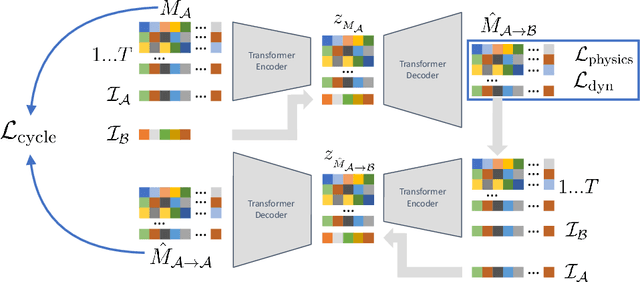

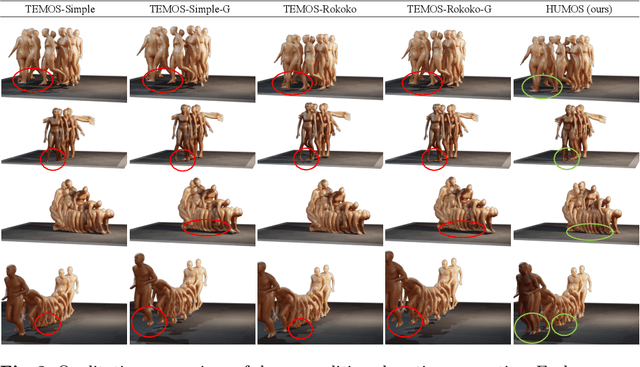
Abstract:Generating realistic human motion is essential for many computer vision and graphics applications. The wide variety of human body shapes and sizes greatly impacts how people move. However, most existing motion models ignore these differences, relying on a standardized, average body. This leads to uniform motion across different body types, where movements don't match their physical characteristics, limiting diversity. To solve this, we introduce a new approach to develop a generative motion model based on body shape. We show that it's possible to train this model using unpaired data by applying cycle consistency, intuitive physics, and stability constraints, which capture the relationship between identity and movement. The resulting model generates diverse, physically plausible, and dynamically stable human motions that are both quantitatively and qualitatively more realistic than current state-of-the-art methods. More details are available on our project page https://CarstenEpic.github.io/humos/.
3D Whole-body Grasp Synthesis with Directional Controllability
Aug 29, 2024Abstract:Synthesizing 3D whole-bodies that realistically grasp objects is useful for animation, mixed reality, and robotics. This is challenging, because the hands and body need to look natural w.r.t. each other, the grasped object, as well as the local scene (i.e., a receptacle supporting the object). Only recent work tackles this, with a divide-and-conquer approach; it first generates a "guiding" right-hand grasp, and then searches for bodies that match this. However, the guiding-hand synthesis lacks controllability and receptacle awareness, so it likely has an implausible direction (i.e., a body can't match this without penetrating the receptacle) and needs corrections through major post-processing. Moreover, the body search needs exhaustive sampling and is expensive. These are strong limitations. We tackle these with a novel method called CWGrasp. Our key idea is that performing geometry-based reasoning "early on," instead of "too late," provides rich "control" signals for inference. To this end, CWGrasp first samples a plausible reaching-direction vector (used later for both the arm and hand) from a probabilistic model built via raycasting from the object and collision checking. Then, it generates a reaching body with a desired arm direction, as well as a "guiding" grasping hand with a desired palm direction that complies with the arm's one. Eventually, CWGrasp refines the body to match the "guiding" hand, while plausibly contacting the scene. Notably, generating already-compatible "parts" greatly simplifies the "whole." Moreover, CWGrasp uniquely tackles both right- and left-hand grasps. We evaluate on the GRAB and ReplicaGrasp datasets. CWGrasp outperforms baselines, at lower runtime and budget, while all components help performance. Code and models will be released.
WANDR: Intention-guided Human Motion Generation
Apr 23, 2024Abstract:Synthesizing natural human motions that enable a 3D human avatar to walk and reach for arbitrary goals in 3D space remains an unsolved problem with many applications. Existing methods (data-driven or using reinforcement learning) are limited in terms of generalization and motion naturalness. A primary obstacle is the scarcity of training data that combines locomotion with goal reaching. To address this, we introduce WANDR, a data-driven model that takes an avatar's initial pose and a goal's 3D position and generates natural human motions that place the end effector (wrist) on the goal location. To solve this, we introduce novel intention features that drive rich goal-oriented movement. Intention guides the agent to the goal, and interactively adapts the generation to novel situations without needing to define sub-goals or the entire motion path. Crucially, intention allows training on datasets that have goal-oriented motions as well as those that do not. WANDR is a conditional Variational Auto-Encoder (c-VAE), which we train using the AMASS and CIRCLE datasets. We evaluate our method extensively and demonstrate its ability to generate natural and long-term motions that reach 3D goals and generalize to unseen goal locations. Our models and code are available for research purposes at wandr.is.tue.mpg.de.
GRIP: Generating Interaction Poses Using Latent Consistency and Spatial Cues
Aug 22, 2023Abstract:Hands are dexterous and highly versatile manipulators that are central to how humans interact with objects and their environment. Consequently, modeling realistic hand-object interactions, including the subtle motion of individual fingers, is critical for applications in computer graphics, computer vision, and mixed reality. Prior work on capturing and modeling humans interacting with objects in 3D focuses on the body and object motion, often ignoring hand pose. In contrast, we introduce GRIP, a learning-based method that takes, as input, the 3D motion of the body and the object, and synthesizes realistic motion for both hands before, during, and after object interaction. As a preliminary step before synthesizing the hand motion, we first use a network, ANet, to denoise the arm motion. Then, we leverage the spatio-temporal relationship between the body and the object to extract two types of novel temporal interaction cues, and use them in a two-stage inference pipeline to generate the hand motion. In the first stage, we introduce a new approach to enforce motion temporal consistency in the latent space (LTC), and generate consistent interaction motions. In the second stage, GRIP generates refined hand poses to avoid hand-object penetrations. Given sequences of noisy body and object motion, GRIP upgrades them to include hand-object interaction. Quantitative experiments and perceptual studies demonstrate that GRIP outperforms baseline methods and generalizes to unseen objects and motions from different motion-capture datasets.
3D Human Pose Estimation via Intuitive Physics
Apr 06, 2023



Abstract:Estimating 3D humans from images often produces implausible bodies that lean, float, or penetrate the floor. Such methods ignore the fact that bodies are typically supported by the scene. A physics engine can be used to enforce physical plausibility, but these are not differentiable, rely on unrealistic proxy bodies, and are difficult to integrate into existing optimization and learning frameworks. In contrast, we exploit novel intuitive-physics (IP) terms that can be inferred from a 3D SMPL body interacting with the scene. Inspired by biomechanics, we infer the pressure heatmap on the body, the Center of Pressure (CoP) from the heatmap, and the SMPL body's Center of Mass (CoM). With these, we develop IPMAN, to estimate a 3D body from a color image in a "stable" configuration by encouraging plausible floor contact and overlapping CoP and CoM. Our IP terms are intuitive, easy to implement, fast to compute, differentiable, and can be integrated into existing optimization and regression methods. We evaluate IPMAN on standard datasets and MoYo, a new dataset with synchronized multi-view images, ground-truth 3D bodies with complex poses, body-floor contact, CoM and pressure. IPMAN produces more plausible results than the state of the art, improving accuracy for static poses, while not hurting dynamic ones. Code and data are available for research at https://ipman.is.tue.mpg.de.
 Add to Chrome
Add to Chrome Add to Firefox
Add to Firefox Add to Edge
Add to Edge